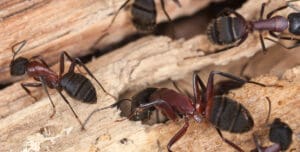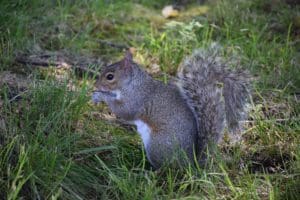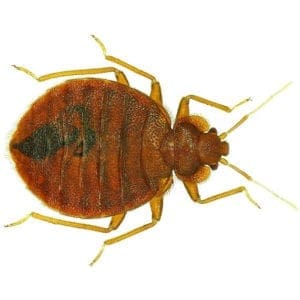

When the weather cools down, outdoor pests like squirrels start looking for warmer places to spend the winter. With their tendency to chew through fascia boards, metal, siding, soffits, and wood to gain access to interiors, squirrels can do a lot of damage once they're inside. Use this identification and prevention guide to keep your home and/or business pest-free all year round.
Identify the Potential Problem
Squirrels belong to the Rodentia scientific order, along with rats. The most common types of squirrel New Jersey home- and business-owners encounter are:
- Eastern Gray Squirrels
Ranging between nine and 12 inches in length, eastern grays have eight inch tails and are named for the color of their fur. They have white stomachs and bodies ranging in color from gray through to red. You also get melanistic and albino Eastern grays, which means they're all-black or all-white.
- Red Squirrels
Just over eight inches long, red squirrels have tails between six and eight inches in length. Their tails are stragglier and shorter than other tree squirrels’. Their bodies range in color from red through to a reddish-gray and their stomachs are cream. They have a ring of white fur around their eyes and occasionally develop black stripes on their flanks over the summer months.
- Flying Squirrels
Because flying squirrels are nocturnal, they're not as frequently seen as the eastern gray or the red. There are two kinds of flying squirrels, northern and southern, but they are very similar. Both the northern and southern flying squirrel have big black eyes and a flat instead of bushy tail. Then they have membranes positioned on their flanks that extend from their front legs to their back legs, which help them soar through the air.
What separates the two species is that the northern flying squirrel is slightly bigger than its southern counterpart, coming in at between 10 and 12 inches long. Southern flying squirrels measure between eight and 10 inches long. The fur on the front of their bellies is also a slightly different color. Northern flying squirrels have white-tipped fur that gets darker as it nears the skin, a characteristic that gives the animal a darker, grayer look. Southern flying squirrels’ stomach fur is completely white, giving them a lighter appearance.

Understand the Possible Damage
Whether eastern gray, northern flying, southern flying, or red, squirrels can cause large-scale damage indoors and out. If they stay outside, the worst you’re looking at is possible destruction of your garden or your outdoor furniture being nibbled on. But gardens are in close proximity to homes and businesses, and if you’re having issues with these rodents in the grounds near your house, there’s always the chance that they’ll find a way to get inside.
Like most gnawing mammals, squirrels can enter spaces through tiny openings. In fact, they’ll get through a golf-ball shaped hole with ease. They can also create entryways where there are none by chewing through shingles, sidings, and/or walls when they want to get inside.
If they gain entry, they will eat whatever they can, although they seem to prefer materials like insulation and wood. These make excellent nesting materials. Chewing through items also strengthens squirrels’ teeth, making it possible for them to keep causing more damage more easily as they go along.
Insulation and wood are relatively easily and cheaply fixed or replaced, but when it comes to things like utility lines and wiring, you’re looking at real problems. Once damaged, these present serious fire hazards. Squirrels can also get to PVC piping and the destruction they cause here can cause flooding.
And squirrels aren’t just in search of shelter when they enter buildings. They're always on the hunt for food as well, so they frequently manage to get to areas where these items are kept, like kitchens and/or pantries. They can contaminate whatever they come into contact with, something which can put the people who live or work in these areas in serious danger.
Squirrels carry diseases like hemorrhagic jaundice, tularemia, leptospirosis, salmonellosis, Lyme disease, and rabies. Above and beyond spreading illnesses directly, they can also do so indirectly, via the fleas and/or ticks they may have on them.
To find out more about the dangers squirrels present in terms of sickness, head over to the Centers for Disease and Control Prevention website. They cover both the diseases directly and indirectly potentially transmitted by squirrels.
Tips to Keep These Pests at Bay
You can’t control the squirrel population in your area entirely, but there are definitely things you can do to minimize your risk:
- Don’t Invite Them In
Food is a massive motivator for squirrels and they’ll keep coming back to wherever they’ve found it before. You might not even be aware of the fact that you’re giving them what they want! Bird feeders, for example, are a great attraction for these rodents. If you have these in your yard, either squirrel-proof them or replace them with ones that have been designed to deter these pests.
Fallen nuts and fruits are also an issue, so rake your garden regularly to dispose of this kind of debris. Focus on the areas around feeders and trees. And ensure that any outdoor garbage cans have tightly fitting lids so that squirrels don’t get lured in by the possibility of the scraps inside them.
- Give Them a Good Scare
A dog or cat in your yard will keep squirrels out for the most part because bigger animals are dangerous to them. Even if you don’t have any pets, however, all is not lost.
You could install motion-activated sprinklers that will spray any pests that enter your garden. You can also purchase containers of predator urine and spray this on your lawn and in your trees. The smell of a wolf or tigers will deter squirrels hugely but you will need to reapply this spray frequently, especially after a rain.
Another option is placing ceramic or plastic owls in your garden. Seeing these birds of prey in an elevated area will scare squirrels away.
- Make Your Garden Less Alluring
If your garden’s landscape isn’t welcoming to them, you’re going to have less of an issue with squirrels. There are certain plants, for example, that these rodents don’t eat or don’t like the smell of. Planting these will repel squirrels without ruining the look of your yard. Introduce allium, snowdrops, daffodils, hyacinths, and geraniums, for example, and enjoy the protection of natural deterrents.
Taste repellents are also available. You could try a compound like capsaicin or opt for a chemical alternative. You’ll need to reapply these after rain, however, and must be careful not to use them on plants that you may eat.
Fences and/or netting around your garden is a good disincentive as well. Just make sure that these are at least 30 inches above ground and 6 inches below.
Squirrel baffles are also excellent options and you can use these on your bird feeder pole if you’ve got one or put them in the trees.

- Remove Potential Pathways
Squirrels can’t cause havoc in areas they're not able to reach. This is why removing possible pathways into your home or business is such an effective method of keeping them under control.
Utility wires are a common way for these rodents to reach attic areas. Prevent this possibility by adding sections of lightweight plastic piping to non-electrical wiring, between two and three inches in diameter. To do this, slit the pipe lengthwise and then open it along this widely enough for it to fit around the wiring. When squirrels try to cross these, the pipe will spin and the rodent will fall.
Keep shrubs and tree branches properly trimmed, too, clear of the outside of your home or business. Squirrels can jump vertically between five and six feet high and horizontally between seven and eight. Trim accordingly and you’ll be deterring both squirrels and rats.
Eliminate points of entry as best you can as well. Remember that squirrels can squeeze through very small gaps, so fix cracks or holes in your building as soon as you notice them. Play close attention to areas like the spaces around doors and windows, eaves, foundations, shingles, siding, and anywhere utility lines enter. Chimneys are also a popular entry point, something you can deal with by installing mesh over the opening.
If you are having an issue with chewing in specific areas repeating, repair as usual and then patch with metal flashing as well, which cannot be chewed through.
- Set Traps if Possible
If you’ve got a serious issue with squirrels on your property already, setting traps may be an option to control the population. This is not legal in all locations, however, so make sure to check whether or not it’s permitted where you are before laying any.
Call an Expert
No matter how closely you follow this advice, you may be fighting a losing battle. This is especially true if you’ve already got an infestation-level of squirrels in your New Jersey home or business. Whatever the case, feel free to contact Twin-Boro for help today. We’ll be able to assist you with your squirrel problem.






